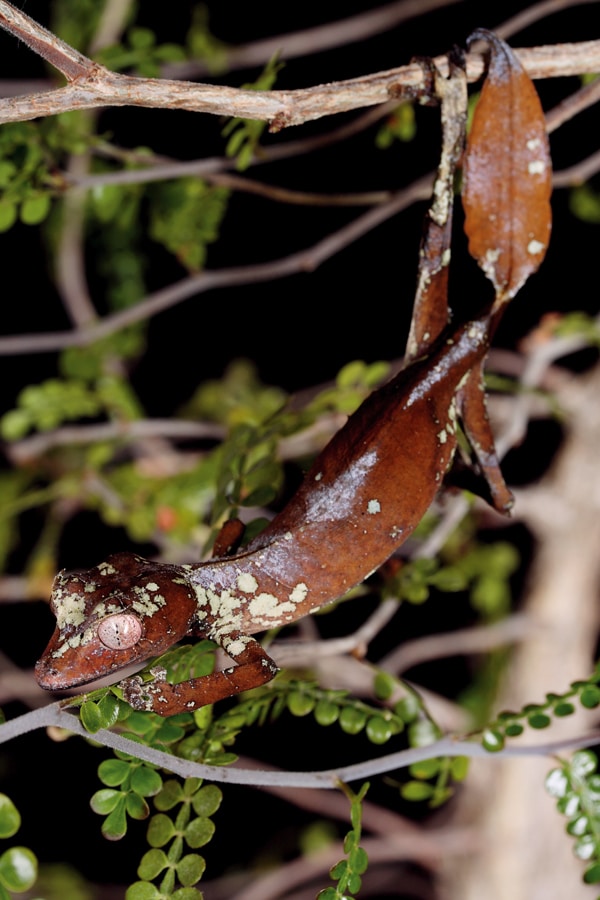There are few animals in the world that exhibit such incredible camouflage as the group of geckos in the genus Uroplatus.
Where’s the gecko?” asks a customer.
“Right there in front of you!” I say, pointing to a branch in the enclosure. Eventually, after some squinting and perplexed looks, they always see it, pretty much right in front of their faces—a foot-long gecko lying motionless, indistinguishable from the branch to which it clings.
Read More
Broad-Leaf-Tailed Gecko Breeding
Satanic Leaf-Tailed Gecko Care Sheet
There are few animals in the world that exhibit such incredible camouflage as the group of geckos in the genus Uroplatus. This remarkable ability is what lures many people into keeping Uroplatus in the first place. Endemic to the island nation of Madagascar, Uroplatus is a diverse group of geckos that includes species ranging in size from a few inches to more than a foot. Coveted by reptile keepers for decades, Uroplatus remain fairly uncommon in home collections, and while captive breeding efforts have grown, success is usually limited to just a few species. However, for keepers who are willing to devote the work required in keeping these geckos properly, there will be great rewards.
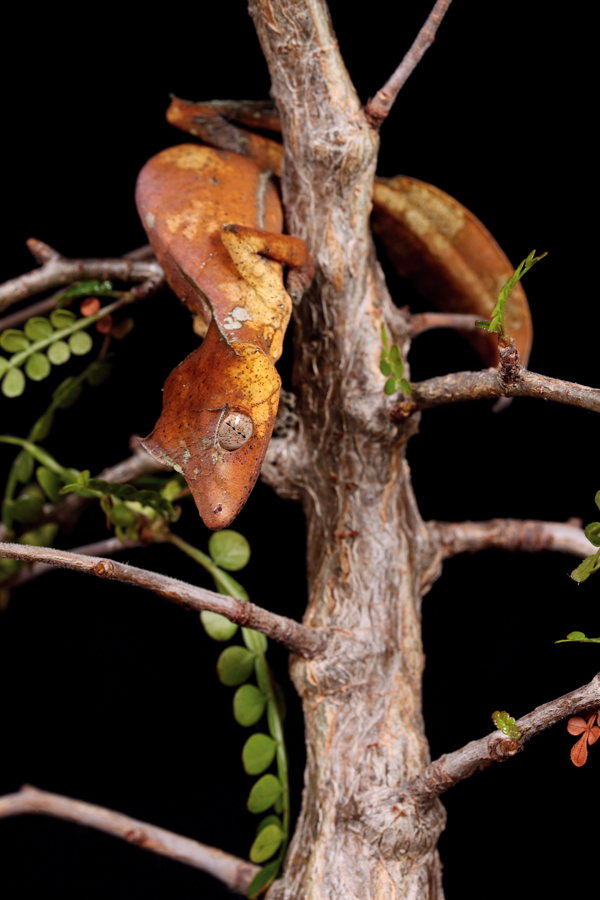
Derek Dunlop
Uroplatus phantasticus likes to climb and will make use of the foliage you place in its enclosure.
Obtaining Uroplatus
Because most are no longer exported from Madagascar and those that are have smaller quota numbers, Uroplatus are increasingly difficult to find for sale. It was once common to see multiple importers offering large numbers of nearly every known (and unknown) species of Uroplatus. Unfortunately, the chance of survival for most imported animals was ill-fated, which gave Uroplatus a reputation for being difficult lizards to keep.
Wild-caught Uroplatus are still offered in small numbers, though captive-bred specimens are usually more frequently seen today. The best way to acquire one would be to purchase directly from a breeder. Wild-caught animals are usually best reserved for experienced keepers looking to diversify their current bloodlines.
Types of Uroplatus
Fimbriatus group:
Uroplatus fimbriatus
U. henkeli
U. sameiti
U. sikorae
U. giganteus
U. aff. henkeli
U. aff. sikorae
Ebenaui Group
U. phantasticus
U. ebenaui
U. finiavana
U. malama
U. aff. ebenaui
Alluaudi group
U. alluaudi
U. guentheri
U. malahelo
U. pietschmanni
Lineatus group
U. lineatus
The most commonly available species are U. henkeli, U. sikorae, U. fimbriatus, U. phantasticus, U. lineatus and U. ebenaui, more or less in that order. The other species remain rare in collections, with most animals retained by serious breeders and sold privately.
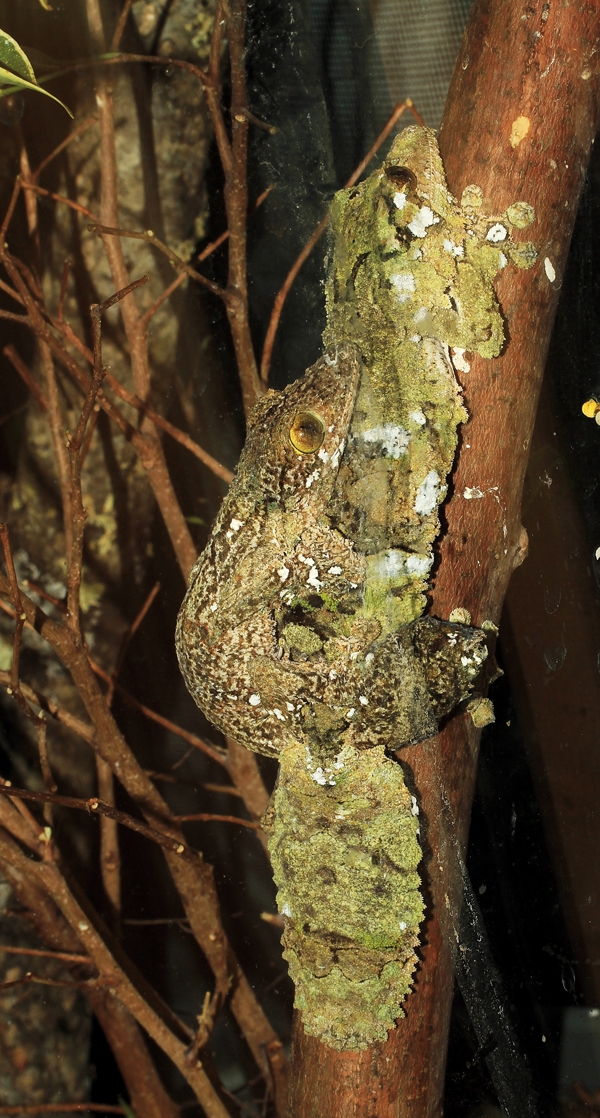
derek dunlop
Two Uroplatus sikorae breeding.
Many Uroplatus that were imported as one species were actually representatives of yet undescribed species, and they have since been reclassified. This may be one reason why earlier breeding attempts were uncommon, as people may have been trying to breed what they thought were two lizards of the same species, when in fact the animals were separate species altogether.
For example, until 2006, U. sameiti was considered to be the same as U. sikorae. The distinction between the two species is now well known. The easiest way to tell them apart is by the color inside the mouth: U. sameiti has a uniformly pink buccal membrane, while U. sikorae has a black one.
Uroplatus ebenaui also caused confusion. When it was being imported, many animals sold as “ebenaui” were in fact an undescribed species (Uroplatus aff. ebenaui). The difference between true ebenaui and the undescribed species is most easily distinguished by the throat color. Uroplatus aff. ebenaui possess a pink buccal membrane, while U. ebenaui has a black one. The head structure also differs, but unless you have a representative of each species side by side to compare, it can be difficult to distinguish the two.
Enclosures Based on Species
Uroplatus are largely endemic to the rain forests of eastern Madagascar, and many species can be kept and bred under similar conditions (the exception being U. guentheri, which inhabits drier deciduous forests in western Madagascar). The main differences in specific care mainly relate to the size and décor of the terrarium.
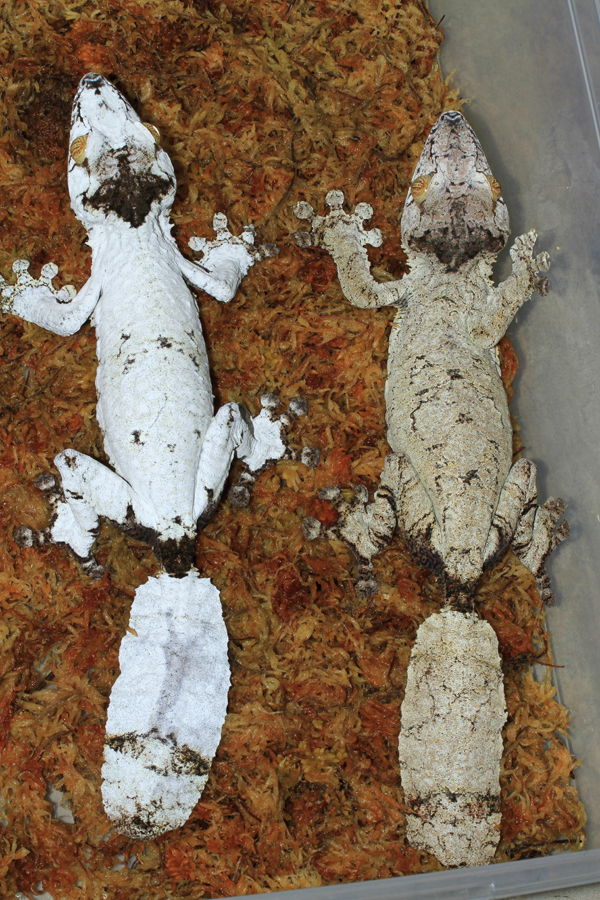
derek dunlop
Even those of the same species, like these U. fimbriatus, will display color and pattern differences.
While husbandry practices for Uroplatus are similar, caging requirements does differ depending on the species being kept. Obviously, larger species will require larger enclosures. That being said, I have had luck with the following recommendations.
Single adults of smaller species such as U. phantasticus and U. ebenaui can be housed in enclosures measuring approximately 10 inches long by 10 inches wide and 20 inches tall. Pairs and trios can be housed in slightly larger enclosures. I used cages measuring 12 by 16 by 20 inches for breeding pairs and trios o f U. phantasticus and U. ebenaui.
Single adults of medium-sized species such as U. guentheri, U. sikorae, U. sameiti and U. pietschmanni can be housed in enclosures measuring 18 by 18 by 24 inches, with 24- by 18- by 30-inch enclosures for pairs or trios.
Larger species such as U. henkeli, U. lineatus and U. fimbriatus will require more spacious enclosures. Single adults should have enclosures no smaller than 24 by 18 by 30 inches. I housed my larger Uroplatus in screen enclosures measuring 2 by 2 by 4 feet, which was large enough to comfortably house up to four individuals.
Screen or Glass?
I have housed Uroplatus in screen cages, partially screened cages, glass and customized Sterilite plastic container bins. Where you live and the conditions inside the room housing the gecko enclosure(s) will determine the best enclosure options for you.
I had a room dedicated to Uroplatus that I more or less treated as a large enclosure by maintaining ambient room conditions that were ideal for the geckos. If room conditions are ideal (e.g., high humidity and appropriate temperature), then screen enclosures are a great housing option because they allow maximum airflow, which is important in reducing stagnant air that can occur in solid-glass enclosures. They also tend to be lighter and less expensive than other caging options of comparable size.
If ambient room conditions are not gecko friendly, then glass or other solid-sided enclosures will allow you to control humidity and temperature levels inside the enclosures themselves. When selecting a glass enclosure it is important to select one that will maintain the conditions the geckos require, and being all Uroplatus are arboreal, cages should be vertically oriented. Regular glass aquariums with large, top-opening screen lids often dry out quickly between mistings (more on them later) and can be difficult to clean without disturbing the animals. I prefer commercially made reptile terrariums over standard fish tanks, as these offer front-opening doors that allow you to clean the terrarium without disturbing the inhabitants. They also often allow for cross ventilation inside the enclosure, which can help reduce stagnant air.
If you have difficulty in achieving optimum conditions in the enclosures mentioned, then you may need to look into building a custom glass cage or plastic enclosure to suit your specific needs.
Go Natural
The décor of a Uroplatus terrarium also varies with species; however, regardless of species, it’s important to utilize as much vertical space as possible. Don’t buy a tall enclosure and leave the top half or third dead space—that defeats the purpose of a tall enclosure.
Uroplatus do best in naturalistic style enclosures, and I always incorporate live plants and branches into their terrariums. Plants I typically use include Ficus, Pothos and Dracaena fragrans, as these are hardy, grow quickly and are available nearly anywhere that sells tropical plants. Once grown into the enclosure they will provide numerous climbing and hiding places for animals.
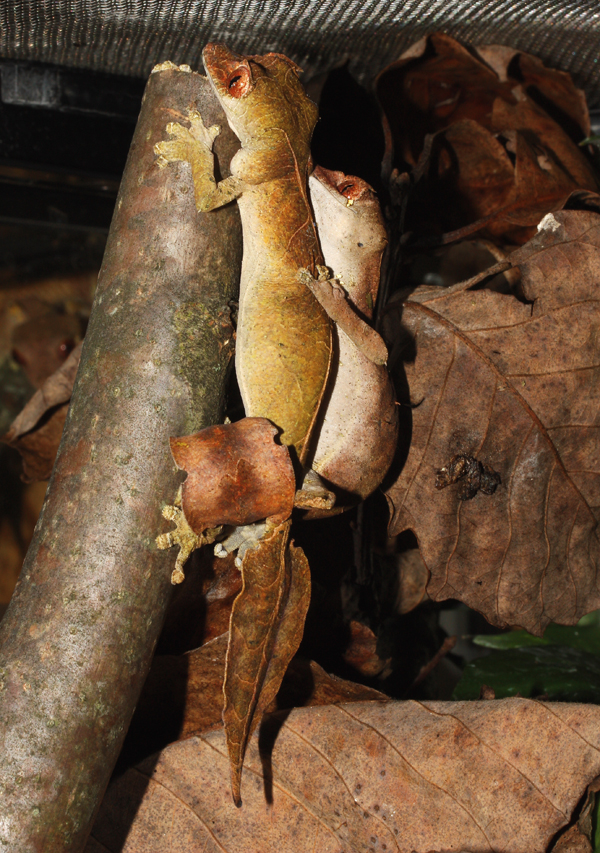
derek dunlop
Breeding U. phantasticas often takes place at night for these nocturnal geckos.
I also use a lot of freshly cut oak and maple tree branches, situated vertically throughout the enclosure. For U. phantasticus and U. ebenaui, I provide branches about the diameter of a pencil; medium-sized species get branches about 1 to 2 inches in diameter, and larger species are given branches with a diameter of 2 to 5 inches. The goal is to provide branches upon which a gecko can comfortably and easily rest upon during the day.
I have also found bamboo to be useful. Uroplatus lineatus, especially, should have bamboo incorporated into its terrarium, as I have noticed this species seems to prefer resting on bamboo over oak or maple branches. More moss-cryptic species such as U. henkeli and U. fimbriatus, on the other hand, prefer to rest on the oak and maple branches.
Uroplatus guentheri I’ve kept seemed to enjoy resting inside bamboo tubes during the daytime. To allow this, simply drill a small entry hole that is just large enough for the gecko to fit through into the side of a bamboo tube. I noticed animals utilizing these retreats frequently, often with gravid females depositing eggs inside the bamboo tubes. Cork bark can also be used with all Uroplatus species. None will make use of it more than U. pietschamanni, which will mimic the bark impeccably while resting on it frequently during the day.
For substrate, 2 or 3 inches of moist peat moss or sphagnum moss will work well in most circumstances. Either can hold a lot of water without turning soggy and will help maintain humidity, and both are commonly available at garden centers. Placing a thin layer of leaf litter over the substrate in small sections of the enclosure can be beneficial if your animals are breeding, as females seem to prefer to deposit eggs directly under the leaf litter or occasionally very shallow in the substrate.
On the Cool Side
Generally, Uroplatus do better when kept at cooler temperatures than other reptile species, and ambient daytime temperatures between 72 and 78 degrees Fahrenheit, with nighttime temps between 60 and 65 degrees, are ideal for them. During the winter, from November through February, I reduce slightly to 68 to 74 degrees during the day and 56 to 64 at night.
Individuals of all species, especially breeding females, will utilize a localized hot spot with temperatures ranging from 90 to 100 degrees, particularly in the morning after the lights have been turned on. Uroplatus guentheri, in particular, seems to relish a hot spot; I observed breeding females concealed in bamboo tubes directly under a hot spot with a temperature of 105 degrees.
I must stress that hot spots must be localized. You don’t want their heat spreading through the terrarium, as Uroplatus will stress and die if they cannot retreat to areas that are maintained at the previously mentioned cooler temperatures.
Light for Nocturnal Geckos
Whether or not Uroplatus need UV is largely debated because of the geckos’ nocturnal lifestyle. Personally, I see no downside in providing it, other than the initial cost of the bulb. However, other breeders have been successful while not providing any UV, so the choice is yours. If you do decide to use it, I recommend a bulb with a 5.0 or 2.0 output. For ambient light, I use UV and full-spectrum lighting on all my enclosures.
Lights should be on 14 hours during March through October, then reduced to 12 hours on from November through February. When the lights are turned off, the room should be completely dark with no other light interference. If any work needs to be done in the room where the enclosures are located after the lights are off, it should be done using a dim flashlight or infrared to reduce the stress on the animals.
Humidity is Crucial
If proper humidity levels are not maintained, Uroplatus can die very quickly. The humidity inside their cages should be between 60 and 100 percent. (Some species, such as U. guentheri and U. pietschmanni, seem able to tolerate short, slightly drier periods.)
How frequently you mist the cage will depend on where you live and conditions in the room where you are keeping the geckos. I live in the southeastern U.S., and my Uroplatus room’s humidity was always around 55 percent. If you live in a drier area, investing in a misting system can be very helpful, as you can set the time when you want the cage to be misted, and for how long. There are also gauges available that will automatically turn on the misting system when the humidity drops below a pre-set level. While this equipment may be expensive initially, it can be a lifesaver when dealing with Uroplatus, as these geckos can dehydrate and die very quickly if not properly hydrated.
For larger species, such as U. fimbriatus, U. henkeli, U. lineatus and U. sikorae, I recommend a 6-inch-diameter water bowl containing 2 to 3 inches of fresh water. I frequently observed animals soaking their cloaca in the water bowls, and they often defecated in them, as well. I am uncertain if these animals are capable of absorbing water via their cloacas, but their frequent use of the water bowls makes me believe providing the bowls is beneficial. All water bowls should be cleaned daily or as needed. Smaller species, such as U. phantasticus and U. ebenaui, do not need water bowls and will drink droplets of water inside the cage after a misting. If you notice any geckos with sunken eyes or a folded tail, this could be a clue that they are becoming dehydrated.
Dinner is Served
Some keepers have noted that various species will eat fruit or pre-made gecko diets, but insects still comprise the bulk of Uroplatus’s diet. Offer appropriately sized crickets and roaches (Blatta lateralis, Blaptica dubia, Gromphadorhina portentosa). Hornworms can be offered once or twice monthly and should be relished by most species. Dust all crickets and roaches every feeding with a 50/50 mix of calcium with D3 and a multivitamin.
Adults of the larger Uroplatus should be offered larger prey items. I often talk to keepers who are feeding crickets to adult U. fimbriatus or U. henkeli and wondering why the animals are thin or not breeding. Offering appropriately sized prey items is better than offering dozens of relatively small prey items. For the gecko, it takes the same amount of energy to stalk and catch a three-quarter-inch cricket as it does a 3-inch cockroach, and I believe it is better for the gecko to stalk a larger prey item that offers a greater return on its energy investment.
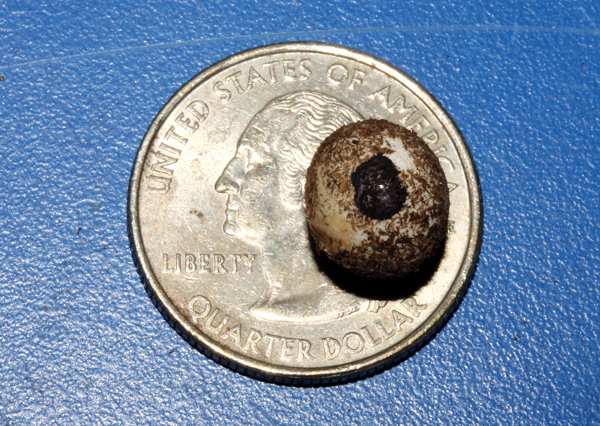
derek dunlop
Leaf-tailed gecko eggs are so small, they will fit on a quarter with space to spare.
The one prey item I believe is crucial for long-term breeding of all Uroplatus is snails. My gravid females often exhibited a very strong feeding response whenever I offered snails, but males accepted them only occasionally. Even if animals were fed crickets and roaches that were heavily dusted every feeding, I would eventually run into calcium issues with females, sometime after just two or three clutches. Then I began offering snails and had much better breeding success. I often used locally sourced snails as well as Helix aspersa. If land snails are not available, aquatic snails can be used. Offer them just after your gecko’s lights are turned off, in a very shallow dish with just enough water to keep the snails alive and moving around.
Other keepers have offered a dish of shredded cuttlebone to Uroplatus and witnessed females eating it directly. I tried this, but never saw my animals eat it, and the cuttlebone usually got wet quickly due to the high humidity inside the enclosures. So I didn’t offer cuttlebone as often as I did snails.
Sexing Uroplatus
Determining the sex of adult Uroplatus is simple. Upon reaching sexual maturity, males of all species have clearly visible hemipenal bulges at the base of their tails.
Sexing younger animals can be trickier, but with some experience you can usually sex young or newborn animals rather easily based on patterning. For instance, males of the U. fimbriatus group sometimes exhibit dorsal striping, while females don’t. Uroplatus lineatus males typically display more splotchy color patterns; females exhibit distinct stripes devoid of any splotches. Lastly, the tails of males in the U. ebenaui group typically resemble a leaf that has been eaten by insects, while females’ tails look like a fresh leaf. Males may also exhibit what looks like a white teardrop below their eyes. Keep in mind that the sexual characteristics described here are all generalities, and there are always exceptions.
Juvenile Care
Care for juveniles is the same as that of the adults, but one of the most vulnerable times in a Uroplatus gecko’s life is right after it emerges from the egg. If conditions are not ideal, especially humidity, hatchling Uroplatus frequently have problems shedding their first shed and they can quickly die if not assisted. If conditions are right, they may shed without you even noticing.
Housing juveniles of smaller species such as U. ebenaui and U. phanatasticus in large deli cups is suitable. Juveniles of larger species can be kept in a small or medium-sized Kritter Keeper. Cage décor should be kept simple: some appropriately sized twigs, bendi vine, and a few plant cuttings. Paper towel can be used as a substrate, though juveniles also do fine on the same substrate used for adults.
Uroplatus grow quite quickly under ideal conditions, and you should increase the size of a juvenile’s terrarium as it grows. Once the gecko is feeding well on its own and has reached at least half the size of an adult animal, then you can move it into a more elaborate, naturalistic enclosure.
Is a Uroplatus Gecko For You?
The geckos that make up the genus Uroplatus are certainly some of the most fascinating and cryptic animals in the world. Despite a rather rocky introduction into herpetoculture, there has been a great deal learned about keeping these geckos in captivity in recent years, and with proper husbandry all Uroplatus are capable of living up to 10 years in captivity. But there still remains a great deal to be learned about them, and many species are still only rarely bred.
While Uroplatus still remain rather uncommon in the mainstream reptile trade, they offer huge rewards to keepers diligent enough to keep them properly. It is imperative that more people succeed in the keeping and breeding of Uroplatus if these wonderful geckos stand any chance of continuing to thrive in the hobby.
Derek Dunlop has bred more than 100 reptile species and maintained a large collection of Uroplatus species. With a bachelor’s degree in ecology/evolutionary biology, he travels the world assisting in fieldwork and photographing reptiles and amphibians in the wild.

